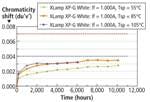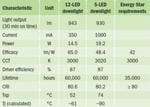This article was published in the February 2012 issue of LEDs Magazine.
View the Table of Contents and download the PDF file of the complete February 2012 issue.
+++++
In the evolution of the microprocessor there have always been uses for faster, more powerful or more compact processors. Historically, with each new generation of microprocessors, electronic devices would in turn become more sophisticated, smaller, faster, and/or cheaper. LED efficacy has been improving similarly to the evolution of the microprocessor, but LED-based illumination designs are not consistently taking advantage of capabilities such as brighter operation at higher drive currents. Today, luminaire manufacturers may find that the surest path to lower system cost is to take advantage of the full LED operating capacity or lumen output that they are already paying for while relying on the growing statistical evidence that they can do so and deliver long product life.
For Cree, the data shows, in the highest quality parts and in well-designed systems, that LEDs can operate at high current and high temperature levels with fewer performance penalties than ever before. This same data calls into question legacy luminaire and driver design methodology that has yielded systems that drive the LEDs around binning-current levels rather than over a wide range of drive currents and temperatures.
Using LEDs at higher operating capacity can deliver more lumens per LED with a corresponding reduction in system cost. For many lighting applications, more aggressively priced products can be created with reduced component count. Such a design methodology can result in higher operating temperatures and lower efficacy. Still, taking full advantage of an LED’s operating capacity becomes an attractive option for applications requiring maximum lumen output at a reduced cost.
Unused operating capacity
Let’s examine the potential of fully using the available LED operating capacity. Previously, a conservative design strategy was appropriate for a relatively young technology such as packaged, high-power LED components. Fig.1 represents that approach at the left side of the shaded area in the light-output/efficacy vs drive-current graph.
Driving LEDs around the binning current has been both an industry-wide habit and an engineering-conservative approach to system reliability. But let’s consider evidence showing that much more aggressive drive currents and temperatures are possible without sacrificing long-term reliability.
Reliability data and projections
LM-80 data sets used to create TM-21 projections are the reliable and standardized method that supports a prediction of a given LED’s lumen maintenance in a system context. The methodology supports prediction of lumen maintenance at the specific operating temperature projected for the system design and application.
Fig. 2 shows L70 LM-80 measured data and TM-21 reported-life projections over three different operating temperatures. TM-21 methodology supports interpolation for projections that fall at operating temperatures between those used in the LM-80 tests.
The relatively lengthy projections of L70 LED life (the operating time before the LED drops below 70% of its initial lumen output) even call into question the use of L70 as a demarcation of useful life. Indeed TM-21 projections reveal that state-of-the-art LEDs can be specified at higher lumen-maintenance levels while still delivering acceptable lifetimes. Consider the following TM-21 projections, based on 10,000-hour LM-80 data sets, for the XLamp XP-G LED driven at 1000 mA at an operating temperature of 85 °C. The L95 reported life is 52,100 hours and the L90 reported life is greater than 60,500 hours.
The concept of using higher drive current also applies to LED families other than the XP-G. For example, the XLamp XM-L family is rated for 3000-mA maximum drive current. At 67% of maximum rated drive current (2000 mA), the TM-21 L70 projections yield a reported value of 36,300 hours based on 6000 hours of LM-80 testing. That 36,000-hour reported result is gated by the LM-80 test time and is valid across the LM-80 temperature range. But the calculated projections range from 2.3 million hours (at 45°C) to 160,000 hours (at 85°C).
Color shift data
In addition to long lumen maintenance, the latest lighting-class LEDs also perform well in terms of color shift. The graph in Fig.3 depicts the color shift in the XP-G LEDs over time and at different operating temperatures. The family maintains shifts of less than 0.004 du’v’ in all cases.
LED-based system design always requires the engineer to evaluate a series of tradeoffs between power consumption, operating temperature, and other elements such as efficacy and droop. The LEDs themselves exhibit quasi-linear performance in a number of their operating parameters. What’s new in the progression of LED technology is that LEDs capable of higher-current operation make the optimization of the non-linear factors (such as droop and hot-cold operational differences) substantially less-pressing design concerns.
Analyzing tradeoffs
Characterization tools offered by LED manufacturers such as Cree can help the design team contemplate the tradeoffs, especially in terms of efficacy. Cree offers its online Product Characterization Tool (PCT) at http://pct.cree.com.
PCT shows that Cree’s brightest cool-white, single-die LED components evaluated at a reasonable operating temperature of 55°C are all capable of delivering component efficacy well above 100 lm/W at elevated drive currents. Similarly with warmer phosphor mixtures, Cree’s brightest warm-white, single-die LED components deliver 75-90 lm/W at 55°C, at drive currents well above the binning current.
While we’ve shown that driving LEDs at higher drive currents and/or elevated temperatures allows the designer to extract more lumens from each LED, there are practical constraints. The lamp or luminaire designer must consider issues such as thermal system design when looking to reduce LED component count and thereby also reducing costs. The following examples illustrate the system considerations.
System constraints
Cree’s XLamp MT-G EasyWhite LED is a multi-die LED, optimized for high-output, small-form-factor, directional lighting applications. The maximum current rating for the MT-G is 4000 mA, a substantial 24W in a 9×9-mm package. But a small-form bulb, such as an MR16, cannot dissipate greater than 20W of thermal load. Fig. 4 depicts the LED alone and designed into an MR16 lamp design.
Based on Cree’s experience in building a MR16 reference design we found that heat sinks for the MR16-class LED sources could safely dissipate 4-7W of power. The geometry of the heat sink constrains the drive capacity of the LED system. Fig 5. shows that, in the case of an MR16 lamp, the LED must be driven relatively close to the binning current and far below the maximum drive current. The MT-G LED, when used with a larger heat sink – such as a heat sink to support a PAR38 bulb application with several times the mass of the MR16 heat sink – can support a much higher drive current.
Cree’s Shenzhen Technology Center has developed other reference designs that illustrate the concept of LED operating capacity tradeoffs. Engineers built two 6-inch recessed downlight fixtures using Cree’s XLamp XP-G LED. Using the same mechanical enclosure and heat sink, but different drivers and numbers of LEDs, we developed two systems with nearly identical light output, distribution, CCT and CRI. One design uses 12 XP-G LEDs being driven at the LED’s 350 mA binning current while the other uses 5 XP-G LEDs driven at 1000 mA.
Note that in some cases Energy Star requirements can also limit the choice of drive currents. Efficacy is a key element in Energy Star and at some point a higher drive current in a particular system design could result in an efficacy spec below the Energy Star limits.
Generally, however, LEDs have far more luminous capacity than most designers are using. The highest quality LEDs are capable of operating at sustained, elevated currents and temperatures far above manufacturers' binning information. New luminaire and lamp designs should take advantage of these attributes. For lighting class LEDs, there is no reliability penalty for using more of this capacity.











